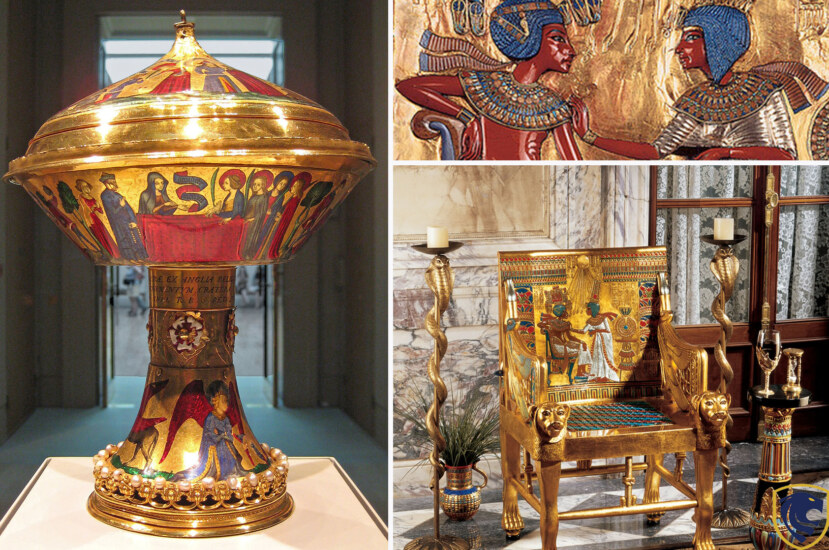Royalty is combined with luxury and comfort. That’s why the accessories that ancient royals used can still mesmerize us.
Russia’s Oldest Crown: The Cap Of Monomakh
The oldest Russian crown is Monomakh’s Cap, which is maintained in Moscow’s Kremlin. It is an ornate gold skullcap made up of eight sections. Each of these is richly decorated with a scrolling overlay of gold filigree and fur on the edges.

The Most Valuable Relics of ancient Royals.; Russia’s Oldest Crown: The Cap Of Monomakh
The cap looks to be an Oriental creation from the late 13th or early 14th century. But a tale from the 15th century claims that Vladimir Monomakh, prince of Kyiv, received the cap from Constantine Monomachus, the Byzantine emperor, in the 12th century. The thick fur border, the side gems, and the top finial ornament are all later embellishments that most likely date to the 16th century.
The Chequers Ring Of Queen Elizabeth I
This locket ring originally belonged to Queen Elizabeth I. And it is presently kept at Chequers, the country residence of the Prime Minister of the United Kingdom. The ring is made of mother-of-pearl and has a gold band with rubies and a single pearl placed into it. Above an enamel “R,” six diamonds are placed to form the letter “E”.

The Most Valuable Relics of ancient Royals.; The Chequers Ring Of Queen Elizabeth I
The locket on the ring, which holds two enamel pictures, is its most intriguing feature. One of the images, which dates to around 1575, unquestionably shows Queen Elizabeth; the other, which shows a woman dressed in 1530s-era attire, shows an unidentified woman.
Whilst many believe it to be Elizabeth’s mother Anne Boleyn, some academics argue that the figure may be Elizabeth’s stepmother Katherine Parr or perhaps a younger version of Elizabeth.
Seal Of Queen Puabi
The Royal Tomb (PG 800), which was built for a prominent woman named Puabi who was pretty certainly a queen, had this cylinder seal. Now you might think that this is just a seal. But the fact that is jaw-dropping is, its age.
From about 3500 BC, tiny cylinders, typically made of stone, were carved in Mesopotamia with a design inverted so that when they were rolled across clay, the design was stamped using pressure. In order to indicate ownership, cylinder seals were wrapped over cuneiform tablets and clay to secure doors and containers.

The Most Valuable Relics of ancient Royals.; Seal Of Queen Puabi
They were also punctured from end to end so that they could be worn. This seal, together with two additional cylinder seals and three gold pins. Those pins apparently used to fasten Puabi’s garment, were discovered next to the fragments of her right arm. It’s possible that the pins were attached to the cylinders.
On cylinder stamps and other Mesopotamian artifacts, narrative episodes were frequently grouped in horizontal bands called “registers.” This seal’s two registers depict banquet scenes, which are representations of drinking and eating with ritualistic or religious overtones.
King Tuts’s Chair
Tutankhamun’s golden seat is a one-of-a-kind piece of art. The elaborate method and numerous intricate details set apart the opulent couch. The fact that its colors have remained vibrant over three thousand years is proof of the great level of craftsmanship achieved by the ancient Egyptian artisans.
The wooden royal throne has a gold and silver finish. Semi-precious stones and colored glass are used as decorations. The throne’s seat is guarded by the heads of two protruding lions. Also, the king’s name is protected by winged serpents wearing Egyptian double crowns on their arms.

The Most Valuable Relics of ancient Royals.; King Tuts’s Chair
In a scenario reminiscent of Amarna, Queen Ankhesenamun is seen behind Tutankhamun’s throne. The queen is applying fragrant oil to her husband’s collar while the sun disc Aten beams above them.
One of art history’s most well-known and personal situations may be seen in this picture, It is the young king who appears to be seated and is being presented with an ointment by his wife Ankhesenamun. The queen dons a diadem, while the king dons a composite crown and a wide collar. Each of them has gorgeous colored glass inlaid into their bodies and wigs, and their linen robes are silver.
The Sword Of State Of Olaf The Black
The ceremonial sword known as the Manx Sword of State stands in for the Tynwald on the Island of Man. It is used each month in Tynwald and yearly at the Tynwald Day ceremony to symbolize the responsibilities of the Isle of Man Sovereign. Over the years, three swords have been employed for these purposes.

The Most Valuable Relics of ancient Royals.; The Sword Of State Of Olaf The Black
One is utilized during the rituals, one is kept in a museum. In addition, another was stolen in the eighteenth century. While it resembles ceremonial swords used in England in the 15th century and is often believed to date to the mid-13th century, the Sword of State really dates to the 15th century according to current studies.
Royal Gold Cup Made For The French Royal Family
The Royal Gold Cup, also known as the Saint Agnes Cup, is a beautifully embellished cup made of solid gold with enamel and pearls. It was created at the end of the 14th century for the French royal family. Also, it then belonged to various English kings before spending over 300 years in Spain. It is generally acknowledged to be the greatest surviving example of a late medieval French plate. And has been displayed in the British Museum since 1892, where it is often on exhibit in Room 40. The “only remaining royal splendor of the European Gothic period” has been spoken of it.

The Most Valuable Relics of ancient Royals.; Royal Gold Cup Made For The French Royal Family
The cup is composed of pure gold. It is 17.8 cm in diameter at its widest point. Also, it is 23.6 cm high and weighs 1.935 kg. It has a removable cover. However, the triangle support it formerly had has been destroyed. The cup’s stem was initially considerably shorter. But it has twice been enlarged by the insertion of cylindric bands, giving the entire design. A molding embellished with 36 pearls has been removed from the cover’s outer border. And a strip of gold with jagged edges may be seen in its place.
And a gold strip with rough edges is apparent where a molding with 36 pearl accents that was affixed to the cover’s outside edge has been removed. It most likely matched the one that was still in place around the cup’s foot.
The Hedwig Beakers
These elaborately crafted glasses are generally known as the Hedwig Beakers, even though not all of them belonged to Saint Hedwig, a duchess of Silesia who was canonized in 1267. The story goes that when Hedwig sipped water from one of these beakers, it changed magically into wine. So, the beakers have been revered as sacred relics ever since.

The Most Valuable Relics of ancient Royals.; The Hedwig Beakers




